Report on the Marketing Intelligence
39 Pages8300 Words52 Views
Added on 2020-05-11
Report on the Marketing Intelligence
Added on 2020-05-11
ShareRelated Documents
Running Head: Marketing intelligenceMarketing Intelligence

Marketing Intelligence 1ContentsTask 1-AIntroduction.............................................................................................................................................1Definition of B2B....................................................................................................................................1Definition B2C........................................................................................................................................2Comparison Chart of B2B and B2C for purchase of Wearable technology.............................................3Conclusion...............................................................................................................................................5Task 1-BBuyer Motives and Adoption of Wearable Technology...............................................................................6Basic needs..........................................................................................................................................6Psychological needs.............................................................................................................................7Self-fulfillment needs..........................................................................................................................7Primary motives:.....................................................................................................................................7Secondary buying motives.......................................................................................................................7Adoption of wearable technology............................................................................................................7Stimuli.....................................................................................................................................................8External Influences..............................................................................................................................8Internal influences...............................................................................................................................8Perceived usefulness............................................................................................................................9Perceived ease of use...........................................................................................................................9Attitude................................................................................................................................................9Behavioral intention............................................................................................................................9Cultural Factors.................................................................................................................................10Personal Factors.................................................................................................................................10Psychological Factors........................................................................................................................10Conclusion.............................................................................................................................................11Task 2AIntroduction...........................................................................................................................................12Segments of wearable technology market..............................................................................................12Regional Analysis..................................................................................................................................13Conclusion:............................................................................................................................................14Task 2 B
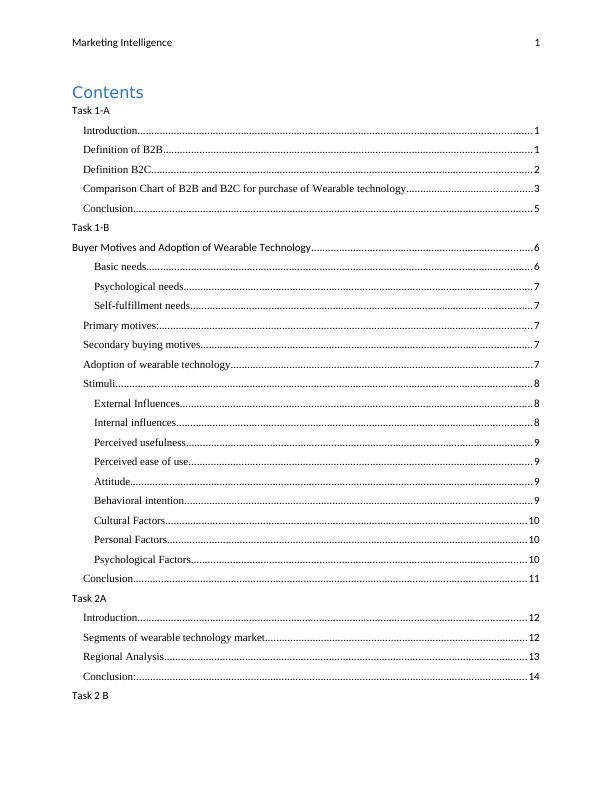
Marketing Intelligence 2Market of Wearable Technology...........................................................................................................15SWOT Analysis of Wearable Technology:............................................................................................15Competitive Analysis............................................................................................................................16Porter’s Five forces analysis:.................................................................................................................17Threat of new entrants.......................................................................................................................17Rivalry among Existing firms............................................................................................................18Threat of substitute............................................................................................................................18Bargaining power of Buyers..............................................................................................................18Bargaining power of Supplier............................................................................................................18Conclusion.........................................................................................................................................18Task 3 Research PlanAbstract.................................................................................................................................................20Background of the study:.......................................................................................................................20Review of literature...............................................................................................................................21Research gap..........................................................................................................................................22Objectives of the study..........................................................................................................................22Research Frame work............................................................................................................................22Hypothesis of the study.........................................................................................................................23Research Design....................................................................................................................................23Descriptive research..........................................................................................................................23Exploratory research..........................................................................................................................23Questionnaire Development..............................................................................................................23Sampling Design:..................................................................................................................................24Sampling Technique..........................................................................................................................24Sample Size.......................................................................................................................................24Data Interpretation and Data Analysis...................................................................................................24Data Interpretation.............................................................................................................................24Data Analysis....................................................................................................................................24Analysis of Measurement Model...........................................................................................................25Task 3 BCustomer Survey................................................................................................................................25Task 3 C PilotSurvey...........................................................................................................................................27References.................................................................................................................................................28
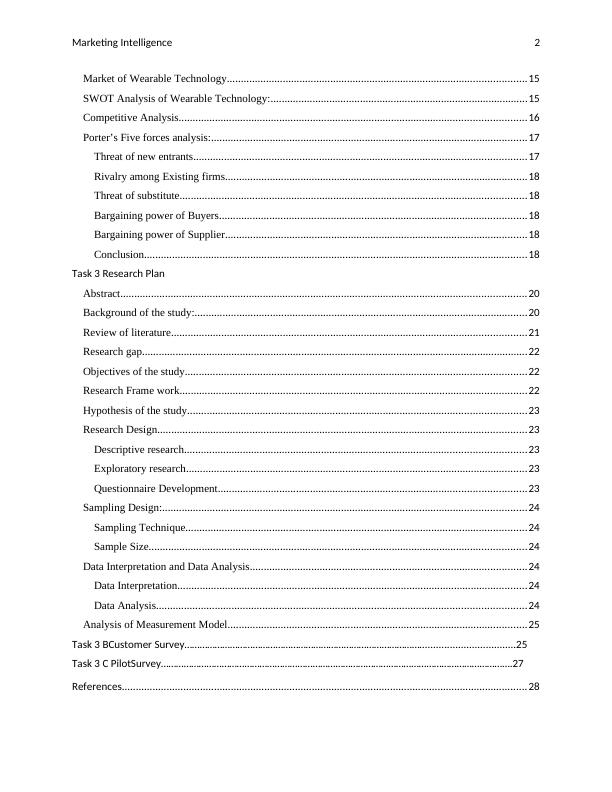
Marketing Intelligence 3Task 1Comparison of B2B & B2C Purchasing situation of WearableTechnologyThe consumer wearable is emerging technology and several IT giants such as Google, Apple andSony are conducting research and development in this technology due to the its extensive potential. It is the next big thing in IT, although wearable is an emerging industry. Today, a largenumber of people are aware of the wearable technology and the products. However, only a few are using wearable technology or have adopted it. The purchase decision regarding the wearable devices is dependent on several factors such as the perceived benefits and ease of use. In the B2Csection, the customers who are health conscious and want to monitor their health are using wearable devices. The major purchase criteria are durability, functionality and comfort. The fitness band is the most popular device and its selection is dependent upon durability, accuracy and the battery life (IMT Digital Health, 2014). Consumer decision making process in B2B products: The buying process in B2B and B2C product purchase are similar to an extent. The major phases in the purchase decision in B2B business model are: a). Recognition of need: In this stage, the need of the potential buyers is recognized. The product manufacturer recognizes that an organization has a need which can be solved by buying a specific product. b). Quantification of Need: In the next stage, a specific group of people who can make a purchase decision set some parameters regarding the product characteristics. They describe what needs to be purchased, features of the product and the quantity of the product. If the product is technical, technical specification of the product also needs to be determined. c). Search for Potential Suppliers: In this stage, the potential customers search for the information for the products which can address their business issues. In the purchase decision process, most of the potential buyers seek out information on the internet for the products which they intend to buy. In B2B setting, the buyers also attend industry trade shows, conventions and obtaining market intelligence from the competitors (Doole & Lowe, 2007). The purchase agents also consider other factors such as which vendor are most qualified, are they reliable and financially stable. d). Requesting for Proposals: Each vendor who can supply the product is asked to send a request for proposal for the good or service. They submit a proposal to supply the goods or services at a specific rate and a specific quantity. The proposal contains several product characteristics such as

Marketing Intelligence 4quality, price, finances, delivery and after-sales services. The vendors also provide samples which can be inspected and tested later. The satisfied customers can also make testimonials which can increase the credibility of the product. Purchase Decision Making Process for B2C Customers There are five steps in the consumer-decision making process for making a product or service purchase. These steps or stages are discussed in the above section. a). Problem identification: The intent for purchase decision initiates with the identification of a problem. The consumers identify a need which needs to be satisfied. b). Search Process: The search process initiates with the researching about the products or services which can satisfy the needs and requirements of the individual. The search engines or the internet is the primary source of information in most of the cases. It provides immediate access and is an easy method to research about the products. c). Evaluation of Alternatives: Once the consumer has compiled all the relevant information about a specific product, they began to evaluate different alternatives. The consumers will look for the best deal and the decision can be based on price, quality and other factors which are essential for making the purchase decision. The customers evaluate the product based on different factors and ultimately choose the product which satisfies most of their parameters. d). Selection stage: It is the next stage in the purchase decision of the customer. After evaluating different choices and the product available for the purchase, the customers decide for the productand its availability. e). Evaluation of Purchase: After making purchase, the customers evaluate the product based on their satisfaction and the set parameters for the product. It is important to deliver a product with supreme quality and optimal price. It ensures that the organization does not gain one-time customer but a lifetime or repeat customer (Doole & Lowe, 2012). A good customer can also increase the customer base by word-of-mouth. Wearable technologies are now gaining importance in the workplace with its advanced features as with these wearable technologies work of employees can be simplified and can help in enhancing the real business value (The wearable future, 2017). The purchasing journey of B2B and B2C is nearly same but have some difference at each stage as the emotional concept and motive of buying the wearable technology is different. As in B2C, consumer is buying for himself whereas in B2B purchasing is done for the organization. In this case, wearable technology purchase for the staff need to cross various steps of buying which includes.
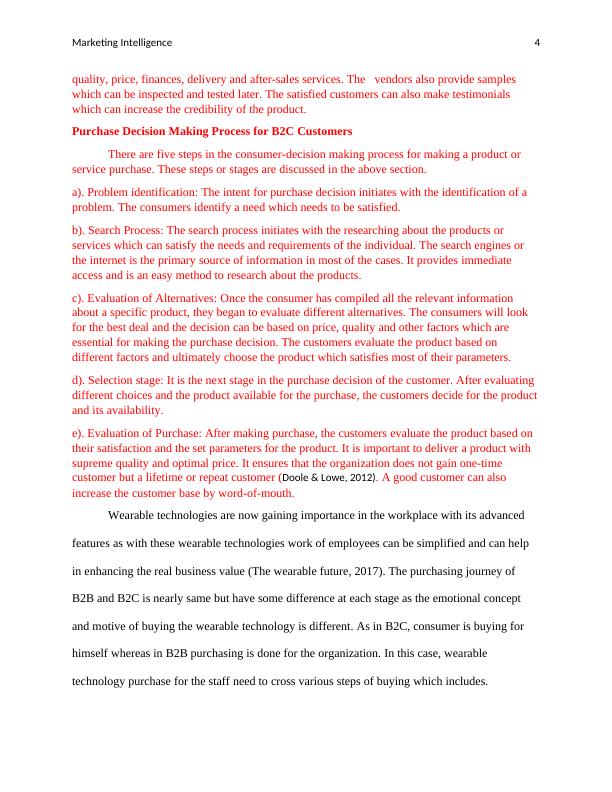
Marketing Intelligence 5Under B2B business model, sale purchase operations is done between two business entities and is known as business to business purchase or sell like supplier and manufacturer, manufacturer towholesaler and wholesaler to retailer. Under B2B decision making is challenging as aims for bulk purchasing. Figure 1.1: B2BSource:http://keydifferences.com/difference-between-b2b-and-b2c.htmlDefinition B2C: Under B2C sales model, selling and purchasing operations is done between business and final consumer. In this model, purchase motive is based on the need of the individual and this selling of goods and value added services are given directly to the customers.
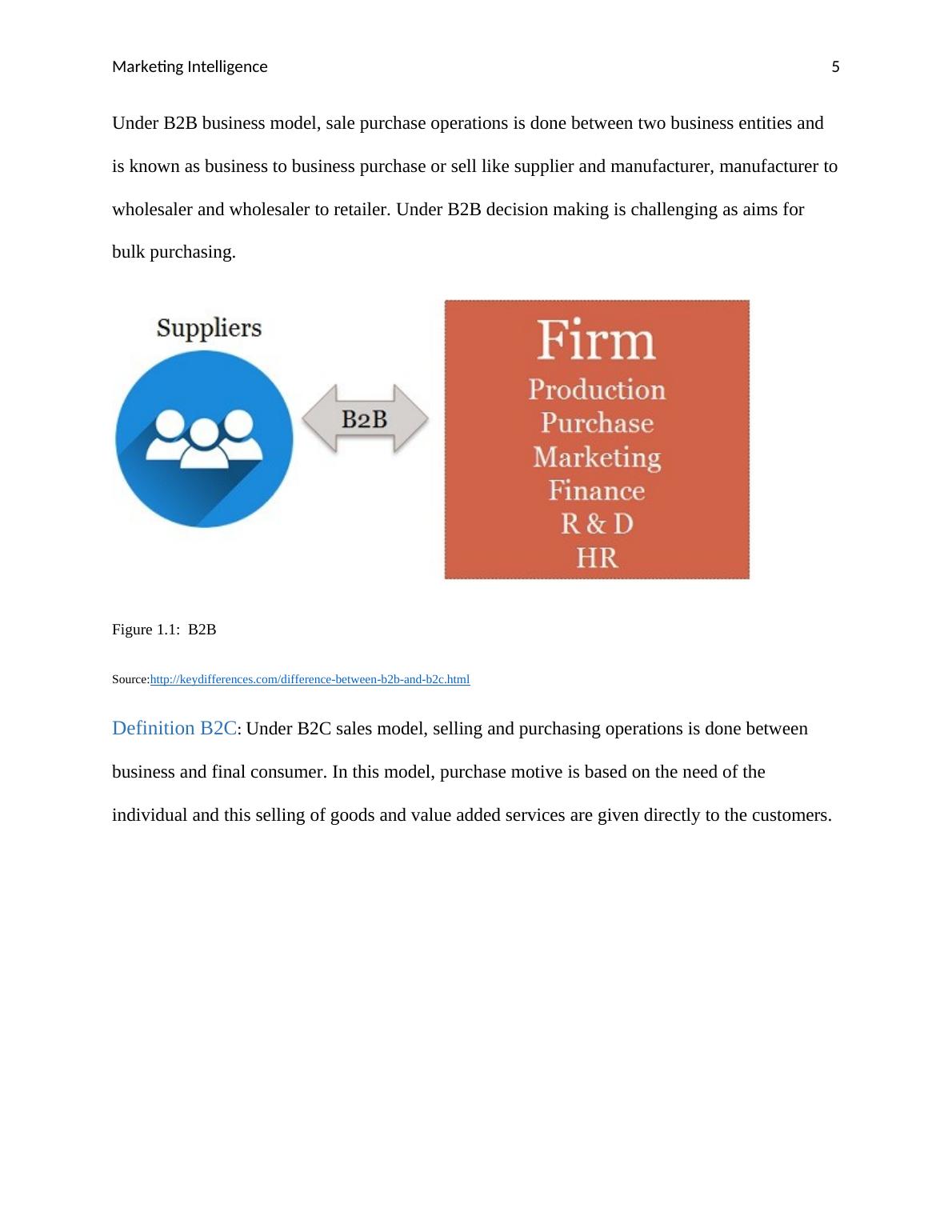
Marketing Intelligence 6Figure 1.2: B2C modelSource: http://keydifferences.com/wp-content/uploads/2015/06/b2c.jpgComparison Chart of B2B and B2C for purchase of Wearable technologyBasis for comparison B2BB2CMeaningPurchase of wearable technology for the organizational purpose direct from the company, for example purchase of wearable technology for the employees of the organizationto increase the productivity and loyalty. Under B2B transaction is between business and businessPurchase of wearable technology for self-use, as a lifestyle accessory, for fitnessunder B2C transaction is between business and consumerCustomerOrganization is the customer for purchase of wearable technology for organizationEnd user or its closed one is only customer for the purchase of wearable technology under B2C
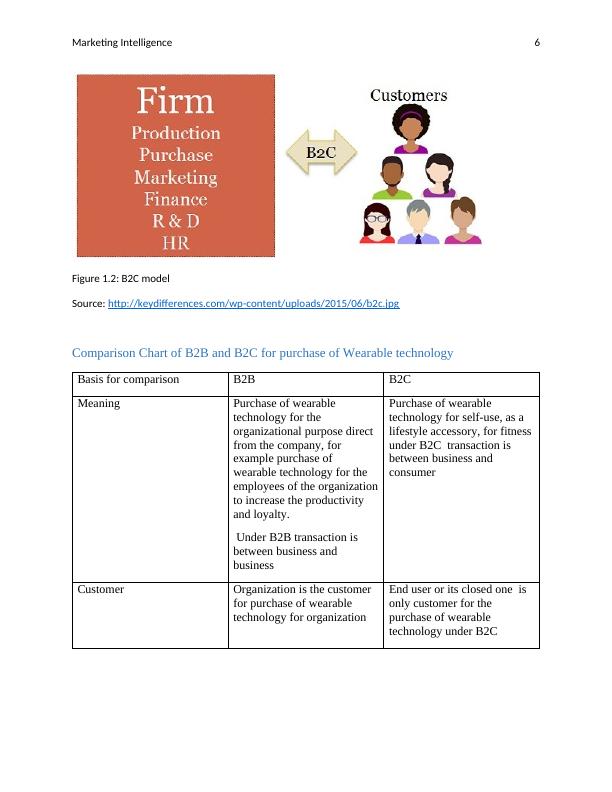
Marketing Intelligence 7Focus onUnder B2B focus in purchaseof item for organizational use is to maintain long-term relationship between both the enterpriseMain focus under B2C purchase of a product is its feature, price quality and aftersale service. Quantity of MerchandiseUnder B2B, quantity of purchase is bulk, as organization aims to give wearable technology to its employee in order to increase loyalty and productivityQuantity of purchase under B2C is small, as end user purchase it for its personal use or for gifting purpose for loved oneRelationship LengthLength of relationship under B2B is long as organization purchase the product in bulk quantity and for this it crosseslong sale cycle and in turn helps in creating long term relationship Relationship length is short asunder B2C customer just contact the retailer check feature if like purchase it.Buying and selling cycleBuying and selling cycle is lengthy because under B2B for the purchase of wearable technology organization will ask for tender then select the supplier if supplier crossed allthe requirement guidelines bulk order is made after payment order is deliveredBuying and selling cycle is short because under B2C if the need arise customer reach to the retailer check the feature if liked will finalize the product and will purchase.Buying DecisionUnder B2B buying decision is will planned based organizational goals, and it is logical with aim of increasingthe growth of the organization Under B2C purchase of wearable technology is emotional based i.e it is basedon the need hierarchy of the individual Creation of brand valueBrand value is created through the trust and mutual relationship created und the buying process of wearable technologyBrand value is created through advertising and promotion and type of value added service given by the retailer
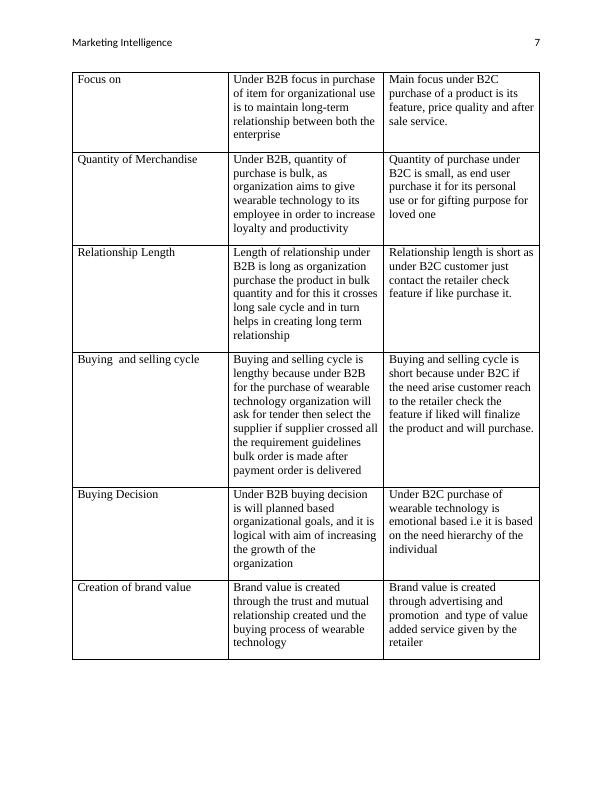
End of preview
Want to access all the pages? Upload your documents or become a member.
Related Documents
Consumer Behaviour and Insightlg...
|12
|3037
|93
Consumer Behaviour and Insightlg...
|16
|5635
|54
Understanding Consumer Behaviour and Decision-Making Process: A Case Study of Apple's iPhone Xlg...
|13
|4532
|2
Research Aims and Objectives Analysis Reportlg...
|52
|14253
|16
Consumer Behaviour and Insightlg...
|11
|3776
|1
Consumer Decision Making Process and Marketing Strategies for B2B and B2Clg...
|12
|4000
|321
